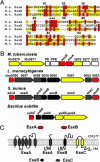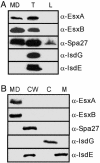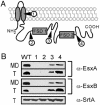EsxA and EsxB are secreted by an ESAT-6-like system that is required for the pathogenesis of Staphylococcus aureus infections
- PMID: 15657139
- PMCID: PMC545836
- DOI: 10.1073/pnas.0405620102
EsxA and EsxB are secreted by an ESAT-6-like system that is required for the pathogenesis of Staphylococcus aureus infections
Abstract
Mycobacterium tuberculosis secretes ESAT-6, a virulence factor that triggers cell-mediated immune responses and IFN-gamma production during tuberculosis. ESAT-6 is transported across the bacterial envelope by a specialized secretion system with a FSD (FtsK-SpoIIIE domain) membrane protein. Although the presence of ESAT-6-like genes has been identified in the genomes of other microbes, the possibility that they may encode general virulence functions has hitherto not been addressed. Herein we show that the human pathogen Staphylococcus aureus secretes EsxA and EsxB, ESAT-6-like proteins, across the bacterial envelope. Staphylococcal esxA and esxB are clustered with six other genes and some of these are required for synthesis or secretion of EsxA and EsxB. Mutants that failed to secrete EsxA and EsxB displayed defects in the pathogenesis of S. aureus murine abscesses, suggesting that this specialized secretion system may be a general strategy of human bacterial pathogenesis.
Figures





References
-
- Rosch, J. & Caparon, M. (2004) Science 304, 1513–1515. - PubMed
-
- Campo, N., Tjalsma, H., Buist, G., Stepniak, D., Meijer, M., Veenhuis, M., Westermann, M., Muller, J. P., Bron, S., Kok, J., et al. (2004) Mol. Microbiol. 53, 1583–1599. - PubMed
-
- Chaatwal, G. S. (2002) Trends Microbiol. 10, 205–208. - PubMed
-
- Madden, J. C., Ruiz, N. & Caparon, M. (2001) Cell 104, 143–152. - PubMed
Publication types
MeSH terms
Substances
LinkOut - more resources
Full Text Sources
Other Literature Sources
Molecular Biology Databases

